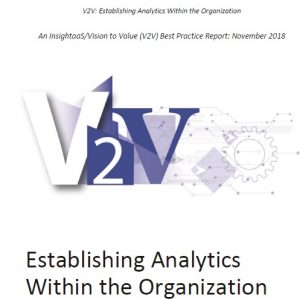Establishing Analytics Within the Organization
The Vision to Value (V2V) community recently published the fourth and final report in the “analytics in a business context” series titled “Establishing Analytics Within the Organization.”

The report is based on the collected insights of 18 Canadian thought leaders, including practitioners and managers within the financial services industry, telecommunications and government organizations, consultants from both global and local firms specializing analytics and BI based projects, academia from leading Canadian universities, subject matter experts from the V2V community and founders from InsightaaS and Information Builders.
It focuses on the issues that are critical to organizations looking to build an evidence-based culture and accelerate the adoption and use of analytics for informed decision making and predictive analysis. The report is structured into five sections.
The first, “Factors in establishing demand for analytics within the organization,” examines five key issues in creating broad acceptance of data use in operations: culture, process evolution, demonstrable success and information utility, plus a review of potential barriers that should be considered as part of this activity.
The second, “the impetus for establishing analytics,” looks at pros and cons of top-down, department-out or blended approaches to expanding the role of data within an organization.
The third section looks at key inputs to the process of establishing analytics within an organization, including skills and training, policies, data quality, relevance and solution licensing.
This is followed by a section discussing how analytics evolves over time and the final section, “the path forward,” offers summary observations that readers may find helpful as they move forward with their own initiatives.
Overall the consensus from the research was that the maturity of the organization and its industry (with respect to use of data to inform decisions) will have a direct impact on the success of the tactics that are used.
To embed Analytics and Business Intelligence with Operations C-Suite leadership is key. The “Chief Data Officer” role is accountable for designing a data strategy that builds support across the organization. Other important roles to build a shared vision and set of values around the use of data include Data Scientists who are responsible for modelling, Data Analysts who derive insights from corporate information, Data Engineers who create the infrastructure and environment needed to support the analysts and data scientists, and a data governance function that includes both “IT and Business Custodians” as Data Stewards.
Use code “SALTV2V4EA” to download and access the report and contact us to discuss how your organization can implement a data-driven culture.
*****
ABOUT THE PUBLICATION
Author: Michael O’Neil, InsightaaS
The “Establishing Analytics Within the Organization” report contains input from 18 Canadian professionals: analytics practitioners, suppliers, academics, and others who are striving to build evidence-based practices and cultures. It contains insight that will be helpful to anyone who is looking to chart a path towards broader adoption of analytics within their organization. The report is structured in five main parts, covering “factors in establishing demand for analytics within the organization,” “the impetus for establishing analytics,” “key inputs to the process of establishing analytics within an organization,” the evolution of analytics within the organization” and “the path forward.”
BusinessOne is a contributing member of the “Establishing Analytics Within the Organization” content co-creation team and helps deliver guidance to organizations that are charting a path towards broader adoption of analytics within their organizations.

